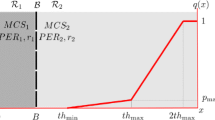Traffic congestion arising from the shared nature of uplink channels in wireless networks can cause serious problems for the provision of QoS to various services. One approach to overcome these problems is to implement some effective congestion control mechanisms at the downlink buffer at the mobile network link layer or at gateways on the behalf of wireless network access points. Active queue management (AQM) is an effective mechanism to support end-to-end traffic congestion control in modern high-speed networks. Initially developed for Internet routers, AQM is now being also considered as an effective congestion control mechanism to enhance TCP performance over 3G links. This paper proposes an analytical performance model for AQM using various dropping functions. The selection of different dropping functions and threshold values required for this scheme plays a critical role on its effectiveness. The model uses a well-known Markov-modulated Poisson process (MMPP) to capture traffic burstiness and correlations. The validity of the model has been demonstrated through simulation experiments. Extensive analytical results have indicated that exponential dropping function is a good choice for AQM to support efficient congestion control.


















Similar content being viewed by others
References
Ryu S., Qiao C. M., Christopher R. (2003). Advances in Internet congestion control. IEEE Communications Surveys and Tutorials 5(1):28–39
B. Braden, D. Clark, J. Crowcroft, B. Davie, S. Deering, D Estrin, S. Floyd, V. Jacobson, G. Minshall, C. Partridge, L. Peterson, K. Ramakrishnan, S. Shenker, J. Wroclawski, and L. Zhang, Recommendations on queue management and congestion avoidance in the Internet, IETF RFC2309. 1998
Floyd S., Jacobson V. (1993). Random early detection gateways for congestion avoidance. IEEE/ACM Transactions on Networking 1:397–413
M. Agfors, R. Ludwig, M. Meyer, and J. Peisa, Queue management for TCP traffic over 3G links, Proc. IEEE WCNC, pp. 1663–1668, 2003
S. Yi, M. Keppes, S. Garg, X. Deng, G. Kesidis, and C. Das, Proxy-RED: an AQM scheme for wireless local area networks. ICCCN, pp. 460–465, 2004
S. Floyd, RED: discussions of setting parameters, http://www.icir.org/floyd/RED parameters.txt, 1997
M. May, C.Diot, B. Lyles, and J. Bolot, Influence of active queue management parameters on aggregate traffic performance, INRIA.RR3995, 2000
Christiansen M., Jeffay K., Ott D., Smith F. (2000). Tuning RED for Web Traffic. IEEE/ACM Transactions Network 9(3):249–264
Floyd S., Fall K. (1999). Promoting the Use of End-to-End Congestion Control in the Internet. IEEE/ACM Transactions Network 7(4):485–472
C. Brandauer, G. Iannaccone, C. Diot, and T. Ziegler, Comparison of tail drop and active queue management performance for bulk-date and web-like internet traffic, Proc. ISCC, pp. 122–129, 2001
M. Agfors, R. Ludwig, M. Meyer, and J. Peisa, Buffer management for rate-varying 3G wireless links supporting TCP traffic, Proc. IEEE 57th VTC, Vol. 4, pp. 675–679, 2003
Q. Pang, S. Liew, C. Fu, W. Wang, and O. Li, Performance study of TCP Veno over WLAN and RED router. IEEE GLOBECOM, pp. 3237–3241, 2003
Xu K., Tian Y., Ansari N. (2004). TCP-Jersey for Wireless IP Communications. IEEE Journa on Selected Areas In Communications 22(4):747–756
Fischer W., Meier-Hellstern K. (1993). The Markov-modulated Poisson process (MMPP) cookbook. Performance Evaluation 18(2):149–171
Min G., Ould-Khaoua M. (2004). On the performance of circuit-switched networks in the presence of correlated traffic. Concurrency – Practice and Experience 16:1313–1326
G. Min and M. Ould-Khaoua, Message latency in hypercubic computer networks with bursty traffic pattern, Journal of Computers and Electrical Engineering Vol. 30, No. 3, pp. 207–222, Elsevier Science, 2004
D. McDysan, QoS & Traffic Management in IP & ATM Networks, McGraw Hill, 1999
T. Bonald, M. May, and J. Bolot, Analytic evaluation of RED performance, Proc. IEEE INFOCOM, pp. 1415–1424, 2000
Author information
Authors and Affiliations
Corresponding author
Rights and permissions
About this article
Cite this article
Wang, L., Min, G. & Awan, I. Modeling and Analysis of Active Queue Management Schemes under Bursty Traffic. Int J Wireless Inf Networks 13, 161–171 (2006). https://doi.org/10.1007/s10776-006-0032-3
Published:
Issue Date:
DOI: https://doi.org/10.1007/s10776-006-0032-3




